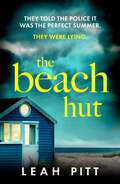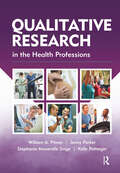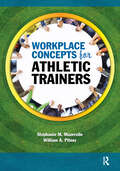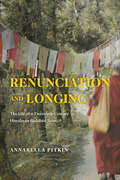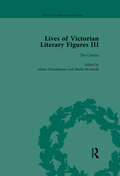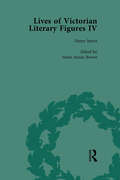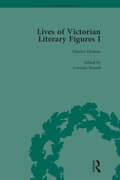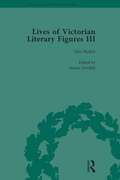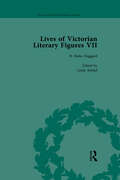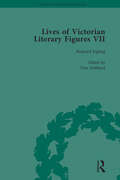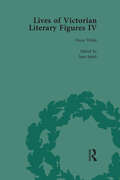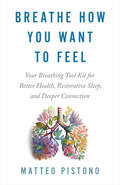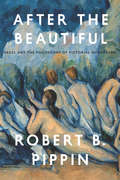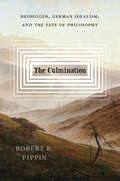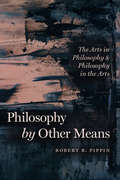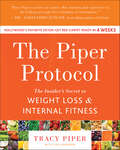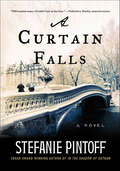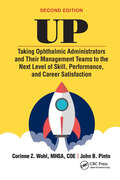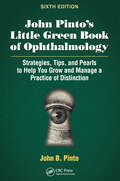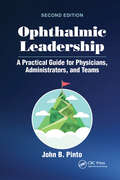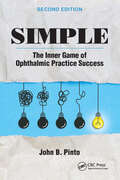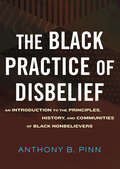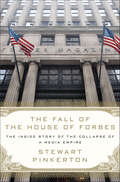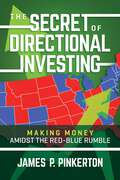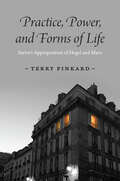- Table View
- List View
The Beach Hut: the most new gripping summer crime thriller - perfect for your holiday this year!
by Leah PittTHEY TOLD THE POLICE IT WAS THE PERFECT SUMMER. THEY WERE LYING.August, 1997. Matilda is killed in a tragic accident on the Dorset rocks, leaving her best friend Sophie alone, wracked with guilt.Decades later, Sophie is back for the first time since that terrible summer, to sell her family's old beach hut and bury the memories forever.But on clearing out the hut, she finds evidence that Matilda's death was no accident. What really happened the night she died?As Sophie edges closer to the truth, the past starts to close in on the present.Because the close-knit community is still home to a killer, and they want Sophie gone.
Qualitative Research in the Health Professions
by William Pitney Jenny Parker Stephanie Mazerolle Kelly PotteigerQualitative research can provide a great depth of understanding for health professionals in practice. Although many general research texts used in health discipline research courses present a broad spectrum of research methods, their discussion of qualitative methods is often limited. Qualitative Research in the Health Professions by Drs. William A. Pitney, Jenny Parker, Stephanie M. Mazerolle, and Kelly Potteiger, is a practical and straightforward text for those learning about qualitative research in the health professions. In Qualitative Research in the Health Professions, readers will acquire skills in mastering:• Introductory concepts of qualitative research, how it compares to quantitative research, and how to conceptualize a qualitative study • How to conduct a qualitative research study and present findings, including sections on collecting and analyzing data, ensuring trustworthiness of the data, and attending to ethical issues • Advanced concepts including various forms of qualitative research, how to mix quantitative and qualitative methods, and how to evaluate qualitative research Each chapter includes activities and exercises to further students’ understanding and the text also includes personal commentaries from scholarly practitioners in various health professions underscoring the value and importance of qualitative research. Qualitative Research in the Health Professionswill help current and future practitioners master the principles of qualitative research, understand published qualitative studies, and apply these findings in furthering evidence-based practice.
Workplace Concepts for Athletic Trainers
by William Pitney Stephanie MazerolleAthletic trainers often find themselves immersed in organizations that can critically influence the way in which they fulfill their professional obligations. The workplace can offer many situations that are challenging, particularly for those athletic trainers who are transitioning into clinical practice.With that in mind, Workplace Concepts for Athletic Trainers provides readers with clear and meaningful information that addresses common concepts and issues that occur in the workplace. The topics selected are a reflection of those covered in the literature as problematic yet identifiable and manageable. Each chapter begins with learning objectives and includes a discussion of the issue itself, how it manifests (sources and antecedents), and strategies and solutions to address the concern.Inside Workplace Concepts for Athletic Trainers, Drs. Stephanie M. Mazerolle and William A. Pitney have infused each chapter with case studies to help readers apply the information presented. The conclusion of each chapter contains a summary, questions for review, and suggested readings to reinforce learning. The recommendations and information presented are designed to improve the workplace culture and climate and provide readers with practical suggestions for dealing with workplace issues.Included with the text are online supplemental materials for faculty use in the classroom.Workplace Concepts for Athletic Trainers is a must-have for any athletic training student transitioning into clinical practice or a clinician seeking help for common issues that occur in the workplace.
Renunciation and Longing: The Life of a Twentieth-Century Himalayan Buddhist Saint (Buddhism And Modernity Ser.)
by Annabella PitkinThrough the eventful life of a Himalayan Buddhist teacher, Khunu Lama, this study reimagines cultural continuity beyond the binary of traditional and modern. In the early twentieth century, Khunu Lama journeyed across Tibet and India, meeting Buddhist masters while sometimes living, so his students say, on cold porridge and water. Yet this elusive wandering renunciant became a revered teacher of the Fourteenth Dalai Lama. At Khunu Lama’s death in 1977, he was mourned by Himalayan nuns, Tibetan lamas, and American meditators alike. The many surviving stories about him reveal significant dimensions of Tibetan Buddhism, shedding new light on questions of religious affect and memory that reimagines cultural continuity beyond the binary of traditional and modern. In Renunciation and Longing, Annabella Pitkin explores devotion, renunciation, and the teacher-student lineage relationship as resources for understanding Tibetan Buddhist approaches to modernity. By examining narrative accounts of the life of a remarkable twentieth-century Himalayan Buddhist and focusing on his remembered identity as a renunciant bodhisattva, Pitkin illuminates Tibetan and Himalayan practices of memory, affective connection, and mourning. Refuting long-standing caricatures of Tibetan Buddhist communities as unable to be modern because of their religious commitments, Pitkin shows instead how twentieth- and twenty-first-century Tibetan and Himalayan Buddhist narrators have used themes of renunciation, devotion, and lineage as touchstones for negotiating loss and vitalizing continuity.
Lives of Victorian Literary Figures, Part III, Volume 2: Elizabeth Gaskell, the Carlyles and John Ruskin
by Ralph Pite Valerie Sanders Aileen Christianson Simon Grimble Sheila A McintoshThomas and Jane Welsh Carlyle moved from rural Scotland to London's Cheyne Walk. This title focuses on writers for whom 'the centre' was a pressing concern. Elizabeth Gaskell, like her contemporary Emily Bronte, was from the north of England, though based in Lancashire and Cheshire rather than Yorkshire. Her first novel, Mary Barton 1848) was set in the north and was unusually realistic in its depiction of Manchester working-class life. Ruskin grew up in suburban London; in later life, he settled in the Lake District . The three volumes that comprise a set are facsimile reproductions of contemporary biographical material. They include letters, memoirs, poems and articles on three outstanding Victorian literary persons: John Ruskin, Elzabeth Gaskell and the Carlyles.
Lives of Victorian Literary Figures, Part IV, Volume 2: Henry James, Edith Wharton and Oscar Wilde by their Contemporaries
by Ralph Pite Elizabeth Nolan Janet Beer Sarah Annes Jane SpiritPart of the "Lives of Victorian Literary Figures" series, this set collects contemporary memoirs, biographies and ephemera relating to Oscar Wilde, Henry James and Edith Wharton. Editorial apparatus includes a general introduction, headnotes, endnotes and a general index.
Lives of Victorian Literary Figures, Part I, Volume 2: George Eliot, Charles Dickens and Alfred, Lord Tennyson by their Contemporaries
by Ralph Pite Gail Marshall Corinna RussellCollected here are the biographies which revealed aspects of their subjects that the more favourable "official" accounts tended to hide. The life of the author of each text is described, and their relation to the writers they portray is sketched in.
Lives of Victorian Literary Figures, Part III, Volume 3: Elizabeth Gaskell, the Carlyles and John Ruskin
by Ralph Pite Aileen Christianson Simon Grimble Sheila A Mcintosh John MullanRuskin grew up in suburban London; in later life, he settled in the Lake District. Thomas and Jane Welsh Carlyle moved from rural Scotland to London's Cheyne Walk. This title focuses on writers for whom 'the centre' was a pressing concern. Elizabeth Gaskell, like her contemporary Emily Bronte, was from the north of England, though based in Lancashire and Cheshire rather than Yorkshire. Her first novel, Mary Barton 1848) was set in the north and was unusually realistic in its depiction of Manchester working-class life.. The three volumes that comprise a set are facsimile reproductions of contemporary biographical material. They include letters, memoirs, poems and articles on three outstanding Victorian literary persons: John Ruskin, Elzabeth Gaskell and the Carlyles.
Lives of Victorian Literary Figures, Part VII, Volume 2: Joseph Conrad, Henry Rider Haggard and Rudyard Kipling by their Contemporaries
by Ralph Pite Keith Carabine Tom Hubbard Lindy StiebelThis book looks at Rider Haggard from a different standpoint, his own. It carries a selection of critical appraisals of Haggard's work by his contemporaries up until the early 1950s.
Lives of Victorian Literary Figures, Part VII, Volume 3: Joseph Conrad, Henry Rider Haggard and Rudyard Kipling by their Contemporaries
by Ralph Pite Keith Carabine Tom Hubbard Lindy StiebelThis book is a collection of biographical records portraying the life of Rudyard Kipling, drawn from official biographies, memoirs, testimonies, letters, diaries, conversations, anecdotes, essays, and reviews.
Lives of Victorian Literary Figures, Part IV, Volume 1: Henry James, Edith Wharton and Oscar Wilde by their Contemporaries
by Ralph Pite Janet Beer Sarah Annes Brown Jane Spirit Elizabeth NolanPart of the "Lives of Victorian Literary Figures" series, this set collects contemporary memoirs, biographies and ephemera relating to Oscar Wilde, Henry James and Edith Wharton. Editorial apparatus includes a general introduction, headnotes, endnotes and a general index.
Breathe How You Want to Feel: Your Breathing Tool Kit for Better Health, Restorative Sleep, and Deeper Connection
by Matteo PistonoBreathwork guide and meditation teacher Matteo Pistono offers a how-to book for upgrading your nervous system to live your optimal life physically, emotionally, and spiritually.Do you want to calm your racing thoughts before lying down for a restful night of sleep? Or raise your energy levels before your morning exercise or spin class, and have laser focus before an important meeting? Are you overwhelmed from the flood of information from your social media and news feed? Any time your emotional state is out of balance, there are time-tested, practical methods to breathe your way back into the state of being you want.You have the capacity to change how you feel, in any moment, when you partner with your breath. It&’s a matter of paying attention and then consciously altering your breathing pattern.Too often books on breathing and breathwork coaches do not teach the actual mechanics of breathing. Instead, they guide one-off sessions, teach protocols, or direct you to an app. The consequence of just following a protocol without understanding breathing mechanics leaves the student disempowered and dependent on the teacher. Instead, in Breathe How You Want to Feel, learning functional breathing becomes the basis upon which you gain control of your well-being—it&’s the secret tool behind resiliency.Breathe How You Want to Feel offers you a psychophysical tool kit that includes:· awareness building,· understanding the dials of your nervous system,· the importance of nasal breathing,· how breath holds (even when very short) are a superpower, and· how to integrate optimal breathing throughout your everyday life, especially when you're sleeping.You&’ll use these tools to optimize your breathing to overcome being tired, wired, and uninspired. You&’ll learn how to breathe optimally during your workday, while exercising, when entering meditative and flow states, and for deep rest. And you&’ll partner with your breath to discover deeper meaning in life. This book meets you, the breather, where you are with step-by-step actionable tools to improve your health, sleep, and well-being.
After the Beautiful: Hegel and the Philosophy of Pictorial Modernism
by Robert B. PippinIn his Berlin lectures on fine art, Hegel argued that art involves a unique form of aesthetic intelligibility—the expression of a distinct collective self-understanding that develops through historical time. Hegel’s approach to art has been influential in a number of different contexts, but in a twist of historical irony Hegel would die just before the most radical artistic revolution in history: modernism. In After the Beautiful, Robert B. Pippin, looking at modernist paintings by artists such as Édouard Manet and Paul Cézanne through Hegel’s lens, does what Hegel never had the chance to do. While Hegel could never engage modernist painting, he did have an understanding of modernity, and in it, art—he famously asserted—was “a thing of the past,” no longer an important vehicle of self-understanding and no longer an indispensable expression of human meaning. Pippin offers a sophisticated exploration of Hegel’s position and its implications. He also shows that had Hegel known how the social institutions of his day would ultimately fail to achieve his own version of genuine equality, a mutuality of recognition, he would have had to explore a different, new role for art in modernity. After laying this groundwork, Pippin goes on to illuminate the dimensions of Hegel’s aesthetic approach in the path-breaking works of Manet, the “grandfather of modernism,” drawing on art historians T. J. Clark and Michael Fried to do so. He concludes with a look at Cézanne, the “father of modernism,” this time as his works illuminate the relationship between Hegel and the philosopher who would challenge Hegel’s account of both modernity and art—Martin Heidegger. Elegantly inter-weaving philosophy and art history, After the Beautiful is a stunning reassessment of the modernist project. It gets at the core of the significance of modernism itself and what it means in general for art to have a history. Ultimately, it is a testament, via Hegel, to the distinctive philosophical achievements of modernist art in the unsettled, tumultuous era we have inherited.
The Culmination: Heidegger, German Idealism, and the Fate of Philosophy
by Robert B. PippinA provocative reassessment of Heidegger’s critique of German Idealism from one of the tradition’s foremost interpreters. Heidegger claimed that Western philosophy ended—failed, even—in the German Idealist tradition. In The Culmination, Robert B. Pippin explores the ramifications of this charge through a masterful survey of Western philosophy, especially Heidegger’s critiques of Hegel and Kant. Pippin argues that Heidegger’s basic concern was to determine sources of meaning for human life, particularly those that had been obscured by Western philosophy’s attention to reason. The Culmination offers a new interpretation of Heidegger, German Idealism, and the fate of Western rationalism.
Philosophy by Other Means: The Arts in Philosophy & Philosophy in the Arts
by Robert B. PippinThroughout his career, Robert B. Pippin has examined the relationship between philosophy and the arts. With his writings on film, literature, and visual modernism, he has shown that there are aesthetic objects that cannot be properly understood unless we acknowledge and reflect on the philosophical concerns that are integral to their meaning. His latest book, Philosophy by Other Means, extends this trajectory, offering a collection of essays that present profound considerations of philosophical issues in aesthetics alongside close readings of novels by Henry James, Marcel Proust, and J. M. Coetzee. The arts hold a range of values and ambitions, offering beauty, playfulness, and craftsmanship while deepening our mythologies and enriching the human experience. Some works take on philosophical ambitions, contributing to philosophy in ways that transcend the discipline’s traditional analytic and discursive forms. Pippin’s claim is twofold: criticism properly understood often requires a form of philosophical reflection, and philosophy is impoverished if it is not informed by critical attention to aesthetic objects. In the first part of the book, he examines how philosophers like Kant, Hegel, and Adorno have considered the relationship between art and philosophy. The second part of the book offers an exploration of how individual artworks might be considered forms of philosophical reflection. Pippin demonstrates the importance of practicing philosophical criticism and shows how the arts can provide key insights that are out of reach for philosophy, at least as traditionally understood.
The Piper Protocol: The Insider's Secret to Weight Loss and Internal Fitness
by Tracy Piper Eve AdamsonA-list celebrity cleanse expert Tracy Piper guides you through a four-week intensive cleanse program structured to change the way you look and feel.Tracy Piper is the go-to guru that A-list celebrities—including actors, models, and musicians, as well as media moguls, eminent doctors and health professionals, and captains of industry rely on to look and feel their best. Now with The Piper Protocol, the star cleansing expert—Hollywood’s best-kept secret—can turn you into one of the “beautiful people.” Tracy’s cleanse program offers an amazing promise: lose 25 pounds in the first month. But weight loss is just the beginning.Tracy’s structured four-week eating plan will change the way you feel and change the way you live. Taking a holistic view, it focuses on weight loss and overall wellness. It’s not entirely vegan. It’s not entirely raw. But it’s very specific, and it works. In The Piper Protocol, she takes you on a tour through the body and explains why cleansing is the key to physical and emotional health; describes how food interacts with the body; and provides a detailed, 28-day eating and supplementation plan that will help you lose up to 25 pounds and start you on the path to a new life.Including step-by-step instructions, helpful drawings, 16 pages of beautiful photography, and delicious recipes for cleansing and rejuvenating foods as well as powerful home remedies, The Piper Protocol will help you slim down, rev up, and get gorgeous.
A Curtain Falls: A Novel (Detective Simon Ziele #2)
by Stefanie PintoffFollowing on the heels of Stefanie Pintoff's acclaimed and award-winning debut, A Curtain Falls is a moody and evocative tale that follows Ziele and his partners as they scour the dark streets of early-twentieth-century New York in search of a true fiend.The careers of New York City detective Simon Ziele and his former partner Captain Declan Mulvaney went in remarkably different directions after the tragic death of Ziele's fiancée in the 1904 General Slocum ferry disaster. Although both men were earmarked for much bigger things, Ziele moved to Dobson, a small town north of the city, to escape the violence, and Mulvaney buried himself even deeper, agreeing to head up the precinct in the most crime-ridden area in the city.Yet with all of the detectives and resources at Mulvaney's disposal, a particularly puzzling crime compels him to look for someone he can trust absolutely. When a chorus girl is found dead on a Broadway stage dressed in the leading lady's costume, there are no signs of violence, no cuts, no bruises—no marks at all. If pressed, the coroner would call it a suicide, but then that would make her the second girl to turn up dead in such a manner in the last few weeks. And the news of a possible serial killer would be potentially disastrous to the burgeoning theater world, not to mention the citizens of New York.
UP: Taking Ophthalmic Administrators and Their Management Teams to the Next Level of Skill, Performance and Career Satisfaction
by John B. Pinto Corinne WohlLike having an expert mentor in your pocket, UP is a powerful, practical workbook designed to take ophthalmic administrators and practice managers to the next level of their careers, offering practical tips, concrete advice, and a step-by-step guide for any hurdle they face. Authors Corinne Wohl and John Pinto are undisputed experts in the field, having decades of experience advising ophthalmic practices of all sizes and publishing numerous books and articles on the subject. In this book, Wohl and Pinto guide administrators toward best practices in coaching and developing their entire management team. UP is also a helpful tool for physician leaders (and leaders in training), who can only accomplish their board-level goals through effective lay managers.UP provides readers with: Practical tips on how to create a customized support and development program for each manager and administrator A step-by-step process for better problem solving Worksheets, insightful self-tests, and scorecards for immediate use as part of a linear career development program
John Pinto’s Little Green Book of Ophthalmology: Strategies, Tips and Pearls to Help You Grow and Manage a Practice of Distinction
by John B. PintoThe classic reference text for surgeons and managers alike that has been improving ophthalmic practices for decades, John Pinto’s Little Green Book of Ophthalmology: Strategies, Tips, and Pearls to Help You Grow and Manage a Practice of Distinction, Sixth Edition, has been updated into a new edition. Author John B. Pinto, a world-renowned expert on the business of ophthalmic practice, has brought his decades of expertise to bear in this comprehensive guide to practice management. Inside, Pinto covers everything from the basics of business planning to esoteric and complex topics unique to ophthalmology. Topics include: Strategic business planning Leadership, governance, and discipline Finance, accounting, and patient accounts management Staff evaluation, training, and supervision Marketing and development Managing physicians Operations enhancement Facility design and management Improving an optical dispensary This Sixth Edition features updates and edits throughout the book as well as 9 new appendices covering the latest trends and advice in ophthalmic administration. It is also designed in a flexible format, allowing readers to read it straight through, or just hunt down advice on the focused problems facing their practice. As the business of ophthalmology continues to change, the proven guidance of John Pinto’s Little Green Book of Ophthalmology, Sixth Edition, will help any practice adapt and thrive.
Ophthalmic Leadership: A Practical Guide for Physicians, Administrators, and Teams
by John B. PintoOphthalmic practices have many types of leaders, functioning at all levels of the organization. Ophthalmic Leadership: A Practical Guide for Physicians, Administrators, and Teams, Second Edition can provide each of these leaders with the tools to be more decisive, motivating, and effective.John B. Pinto, America’s most published author on the business of ophthalmology, has firsthand experience with the best and worst practice leadership habits from his decades of experience as an ophthalmic practice consultant. He has coached countless physician and lay leaders to the next level of their careers. Together with his team of more than 20 expert contributors, Pinto covers every aspect of leadership in ophthalmology, no matter the size of the practice or the current experience of the team.Chapters include: What Do You Believe in? Developing a List of Core Values for Your Practice Grooming and Moving Line Staff Up to Middle Management Contingency Planning in a Less-Certain Environment Leading Your Team Past the Inevitable Conflicts of Practice Life Everyone in ophthalmology can benefit from the lessons inside Ophthalmic Leadership: A Practical Guide for Physicians, Administrators, and Teams, Second Edition—from the rising ophthalmic technician or department manager, to the managing partner, and even the most seasoned practice administrator.“The book you now hold is a wonderful opportunity to rededicate yourself to your professional development as a leader and to the success of your organization.”From the Foreword by Richard L. Lindstrom, MD
Simple: The Inner Game of Ophthalmic Practice Success
by John B. PintoNow in its Second Edition, Simple: The Inner Game of Ophthalmic Practice Success makes even the most complex issues in ophthalmic practice management just that- simple. This handy guide covers everything from the basics of business planning to esoteric and complex topics unique to ophthalmology.Author John B. Pinto, a world-renowned expert on the business of ophthalmic practice, has brought his decades of expertise to bear in this high-yield handbook. Throughout his career he has seen that the most successful practices large or small have learned to see the big picture and keep things simple. This book helps practice owners, managers, and administrators achieve that goal.Simple cuts through the details and the minutia of running a practice to refocus on the big picture and the key, high-impact factors influencing ophthalmic practice success. Each chapter addresses a new topic, pointing out stumbling blocks and key areas to focus on so practice owners and managers can stick to their strategic goals. With a foreword by Dr. Richard Lindstrom and hundreds of management pearls throughout, Simple: The Inner Game of Ophthalmic Practice Success, Second Edition takes the guesswork out of running an ophthalmic practice. From data analytics to the ins and outs of administration, John B. Pinto makes practice management simple.
The Black Practice of Disbelief: An Introduction to the Principles, History, and Communities of Black Nonbelievers
by Anthony PinnA short introduction to Black Humanism: its history, its present, and the rich cultural sensibilities that infuse itIn the United States, to be a Black American is to be a Black Christian. And there&’s something to this assumption in that the vast majority of African Americans are Christian. However, in recent years a growing number of African Americans have said they claim no particular religious affiliation—they are Black "nones." And of these Black "nones," the most public and vocal are those who claim to be humanists.What does it mean to be a Black humanist? What do Black humanist believe, and what do they do? This slim volume answers these questions. Animated by six central principles, and discussed in terms of its history, practices, formations, and community rituals, this book argues that Black humanism can be understood as a religious movement. Pinn makes a distinction between theism and religion—which is simply a tool for examining, naming, and finding the meaning in human experience. Black humanism, based on this definition isn&’t theistic but it is a religious system used to explore human experience and foster life meaning. It infuses humanism with rich cultural sensibilities drawn from Black experience. As shown in these pages, thinking about Black humanism this way frees readers from making unfounded assumptions and enables them to better appreciate the secular &“beliefs,&” ritual structures, and community formation constituted by Black humanists.
The Fall of the House of Forbes: The Inside Story of the Collapse of a Media Empire
by Stewart PinkertonForbes: the legendary name in finance journalism. Synonymous with wealth, grand excess, glamour, and fun as well as style, insight, gossip, and hard-nosed reporting, the media empire and the family behind it form a remarkable story that has never been told. Now, in The Fall of the House of Forbes, veteran journalist Stewart Pinkerton reveals the hidden machinations, disastrous decisions, and personal foibles of a century-old dynasty that rose to glittering heights and crashed just as spectacularly.Writing from an insider's perspective and first-hand sources developed over his twenty years as a writer and editor at Forbes, Pinkerton takes us to the ritualized formal lunches inside the mansion-like headquarters at 60 Fifth Avenue in Manhattan; the lavish advertiser parties on board the family yacht, The Highlander; the sybaritic private life of Malcolm Forbes and the family's increasing discomfort with its patriarch; and the glory days of the magazine, with its news-making stories, high-rolling expense accounts, and bar-setting standards for anyone who aspired to wealth and its trappings. But as the media business changed, Forbes was slow to react, and found itself burdened by Malcolm's immense personal expenses, Steve Forbes's bumbling, self-financed presidential campaigns, and the family's hubris and hesitation in the face of reality. A series of devastating business decisions and an internecine struggle for power forced the sale of the Faberge eggs, the vintage toy collection, the homes, the private island, the yacht, and finally the sale of 40% of the company itself to outside investors…a collapse of shocking speed after decades of unsurpassed success.A compelling narrative account of a powerful family's dysfunction, The Fall of the House of Forbes is a parable of capitalism at its best and worst, and a metaphor for the current state of digital turmoil in media.
The Secret of Directional Investing: Making Money Amidst the Red-Blue Rumble
by James P. PinkertonTo know the trend, spot the trend, or shape the trend is to make money.The trend is your friend—investors know that. But the biggest money comes from the biggest events. The more delta, the more alpha.In that spirit, The Secret of Directional Investing offers a new way of thinking about investing, steeped in culture and history. Focusing on megatrends, this book points out ways to profit from an understanding of two kinds of trends: those that can be spotted, and those that can be shaped. There&’s money in both. The Romans weren&’t kidding when they said, Audentes Fortuna luvat—Fortune favors the bold. The Secret of Directional Investing is a bold look at investments and potential investments.
Practice, Power, and Forms of Life: Sartre’s Appropriation of Hegel and Marx
by Terry PinkardPhilosopher Terry Pinkard revisits Sartre’s later work, illuminating a pivotal stance in Sartre’s understanding of freedom and communal action. Jean-Paul Sartre’s Critique of Dialectical Reason, released to great fanfare in 1960, has since then receded in philosophical visibility. As Sartre’s reputation is now making a comeback, it is time for a reappraisal of his later work. In Practice, Power, and Forms of Life, philosopher Terry Pinkard interprets Sartre’s late work as a fundamental reworking of his earlier ideas, especially in terms of his understanding of the possibility of communal action as genuinely free, which the French philosopher had previously argued was impossible. Pinkard reveals how Sartre was drawn back to Hegel, a move that was itself incited by Sartre’s newfound interest in Marxism. Pinkard argues that Sartre constructed a novel position on freedom that has yet to be adequately taken up and analyzed within philosophy and political theory. Through Sartre, Pinkard advances an argument that contributes to the history of philosophy as well as key debates on action and freedom.
